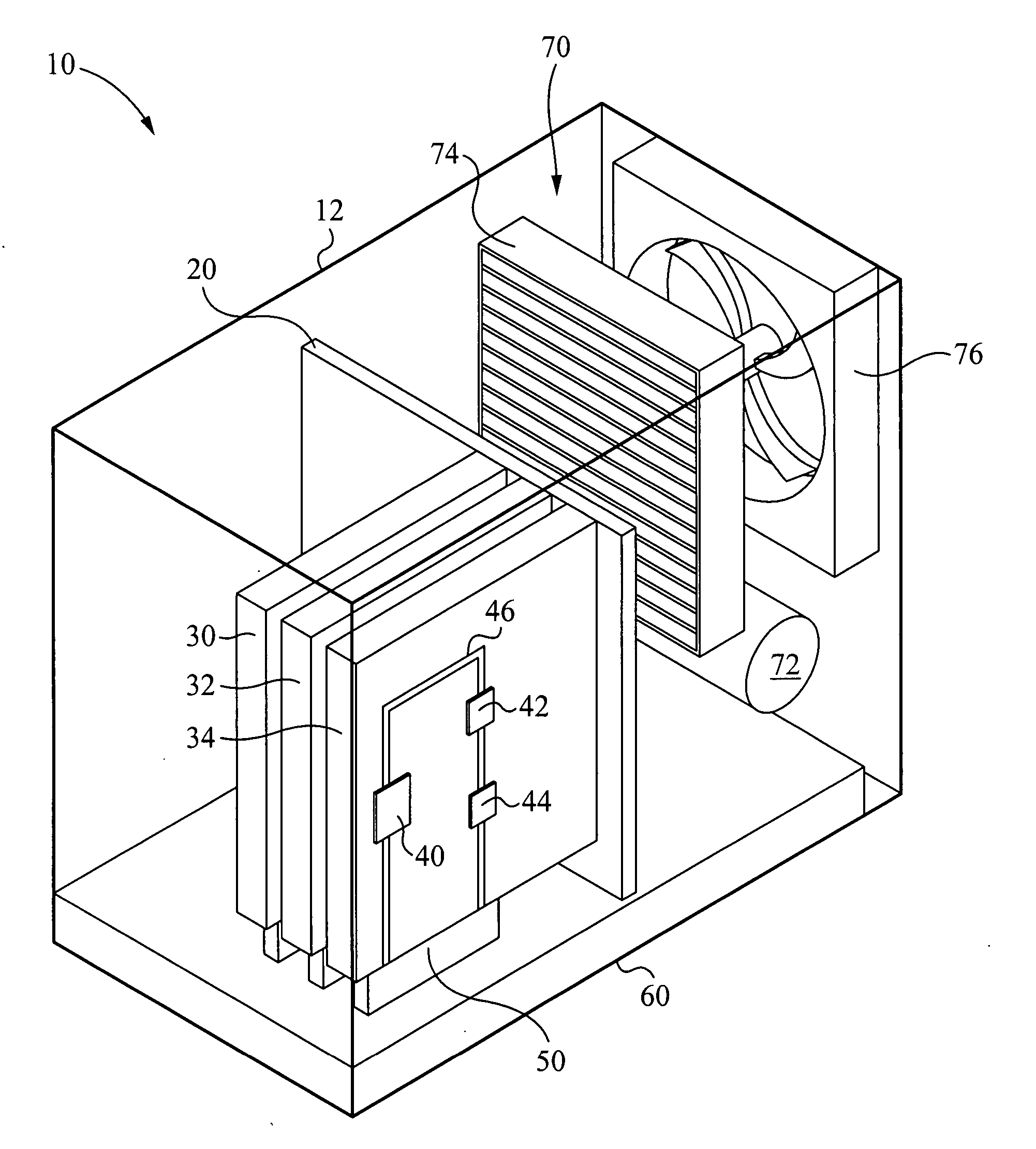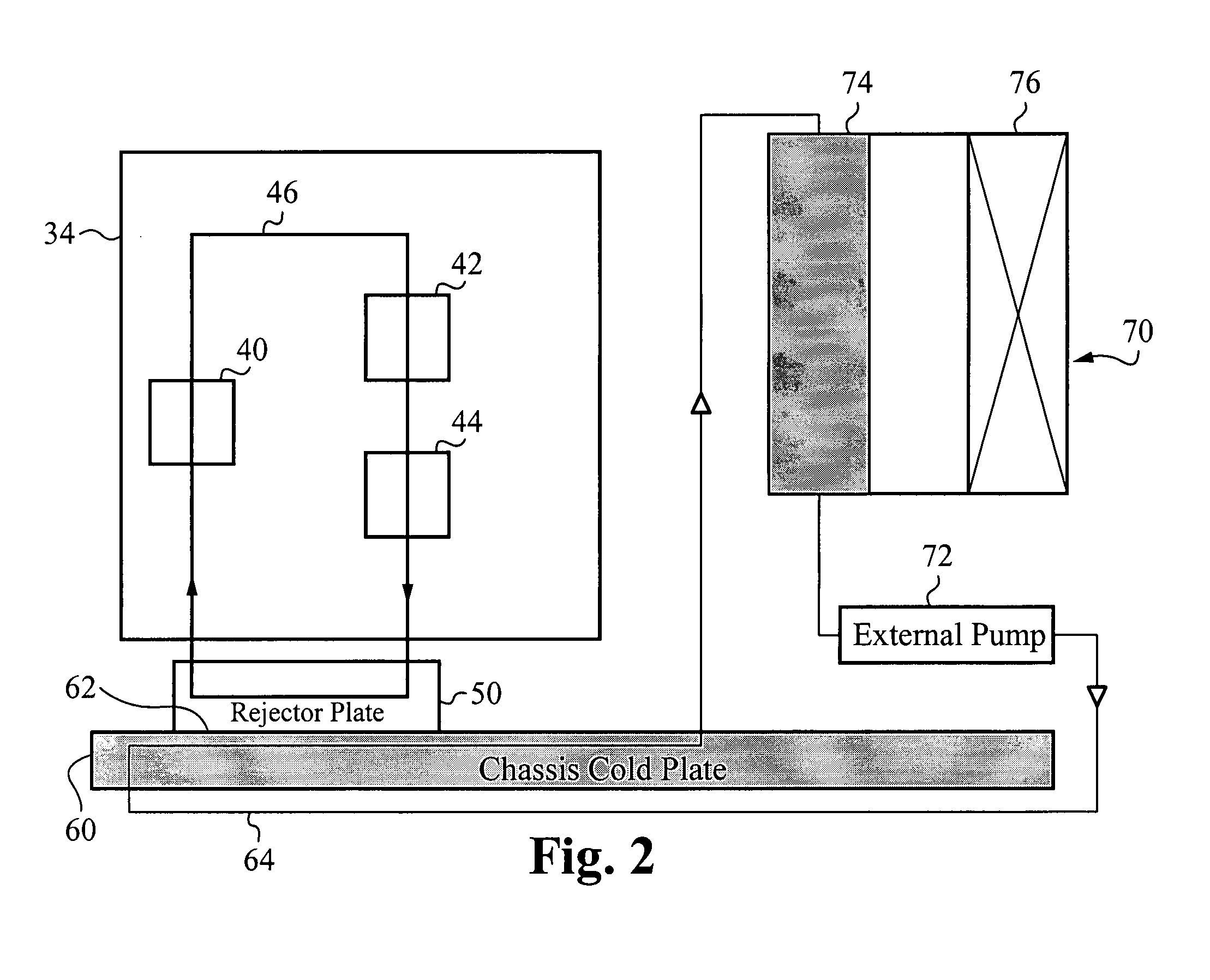Liquid cooling loops for server applications
a server application and cooling loop technology, applied in the direction of lighting and heating apparatus, electrical apparatus casings/cabinets/drawers, furniture parts, etc., can solve the problems of high thermal density, insufficient cooling chips in conventional cooling with heat pipes and fan mounted heat sinks, and significant challenges in high-performance integrated circuit cooling. , to achieve the effect of increasing surface area and low thermal resistan
- Summary
- Abstract
- Description
- Claims
- Application Information
AI Technical Summary
Benefits of technology
Problems solved by technology
Method used
Image
Examples
first embodiment
[0045] In a first embodiment, the liquid based cooling system for each electronics server includes a rejector plate. The fluid lines coupling the MCPs and the server pump are also coupled to the rejector plate with fluid channels configured therein. The MCPs, the server pump, the rejector plate, and the fluid lines connected thereto form a first closed loop. Each server chassis includes at least one chassis cold plate. The rejector plate is coupled to the chassis cold plate via a thermal interface material. The rejector plates for each of the electronics servers are coupled to the chassis cold plate in this manner such that all rejector plates, and therefore the cooling system for each electronics server, are coupled to the chassis cold plate. Each electronics server is installed into a backplane along an insertion vector. The thermal interface between the rejector plate of the electronics server and the chassis cold plate is formed along a non-perpendicular plane relative to the in...
second embodiment
[0061]FIG. 3 illustrates a side view of an exemplary cooling system according to the present invention. The cooling system 110 can be identical to the cooling system 10 of FIG. 1 with the exception that the liquid-to-air heat exchanging system 70 (FIG. 1) of cooling system 10 is replaced by an external water supply 170. The external water supply 170 represents a continuous running water supply, such as the public water supply provided to most commercial and residential facilities. Alternatively, the external water supply 170 represents an external source of any type of fluid to which heat is transferred. In operation of the cooling system 110, fresh water from the external water supply 170 flows to the chassis cold plate 60. Heat from the chassis cold plate 60 is transferred to the water in the same manner as that described in relation to cooling system 10 (FIG. 1). The heated water flows from the chassis cold plate 60 to the external water supply 170, where the heated water is disp...
third embodiment
[0063]FIG. 5 illustrates a side view of an exemplary cooling system 210 according to the present invention. Although cooling system 210 is shown in FIG. 5 as including only a single electronics server 134, it is understood that the cooling system 210 also includes a chassis housing (not shown) and a back plane (not shown) configured to hold up to N electronics servers in a manner similar to that described in relation to cooling system 10 in FIG. 1. For purposes of discussion, each electronics server within the cooling system 210 is described as including two processors. It is again understood that each electronics server in the cooling system 210 can be configured independently and that each electronics server can include more or less than two heat generating devices, such as processors.
[0064] A liquid based cooling system is coupled to the electronics server 134. The liquid based cooling system includes an MCP 142 and an MCP 144 coupled together via one or more fluid lines 146. The...
PUM
 Login to View More
Login to View More Abstract
Description
Claims
Application Information
 Login to View More
Login to View More - R&D
- Intellectual Property
- Life Sciences
- Materials
- Tech Scout
- Unparalleled Data Quality
- Higher Quality Content
- 60% Fewer Hallucinations
Browse by: Latest US Patents, China's latest patents, Technical Efficacy Thesaurus, Application Domain, Technology Topic, Popular Technical Reports.
© 2025 PatSnap. All rights reserved.Legal|Privacy policy|Modern Slavery Act Transparency Statement|Sitemap|About US| Contact US: help@patsnap.com



